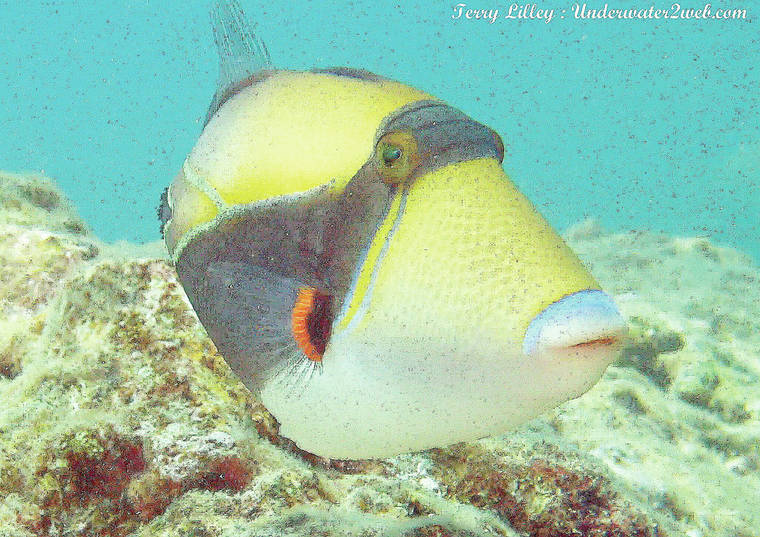Meet humuhumunukunukuapuaa, the wedgetail triggerfish! This iconic Hawaiian reef fish is also known at the Picasso triggerfish, and its Hawaiian name has a fascinating meaning of which is still not completely understood. I worked with Rubellite Kawena Johnson on the possible interpretation of the long Hawaiian name given to this fish, and so far this is what she came up with. Auntie Ruby is one of the best Hawaiian linguists on earth, and she transcribed the oral Hawaiian Chants of Creation into English. This famous document is called the Hawaiian Kumulipo. The Hawaiians had an oral language, not a written language, so it is often difficult to go back in time and interpret these ancient chants into English!
Meet humuhumunukunukuapua‘a, the wedgetail triggerfish! This iconic Hawaiian reef fish is also known at the Picasso triggerfish, and its Hawaiian name has a fascinating meaning of which is still not completely understood. I worked with Rubellite Kawena Johnson on the possible interpretation of the long Hawaiian name given to this fish, and so far this is what she came up with. Auntie Ruby is one of the best Hawaiian linguists on earth, and she transcribed the oral Hawaiian Chants of Creation into English. This famous document is called the “Hawaiian Kumulipo.” The Hawaiians had an oral language, not a written language, so it is often difficult to go back in time and interpret these ancient chants into English!
We know that the first “humu” in the fish name refers to a “stitched pattern,” of which is the design on the side of the fish. But what does the second “humu” mean? Lots of folks have interpreted this in different ways but Ruby discovered a meaning that may go back over 4,000 years!
In the movie “The World’s Guide to Hawaiian Reef Fish” I talk about how this fish knows every passageway through the reef. When the triggerfish is alarmed it darts into a hole in the reef and puts up its dorsal fin that is ridged and pointed. This “trigger” locks the fish into the hole so it cannot be pulled back out. The triggerfish sometimes will dart into a hole that has an exit on a different part of the reef so it disappears into one side of the reef and may come out on the other side of the reef.
When Ruby watched my movie it gave her a research idea. Sure enough, she found a very-old reference to a star 4,000 years ago that had its own “passageway” through the galaxy. It was called the Humu star! Ruby also found an old Hawaiian chant that referred to a “passageway” through the reeds in the back side of Pearl Harbor dating back over 1,000 years ago. In the chant the passageway was referred to as a humu.
So maybe the real name for this fish may be “the fish with a stitched pattern that knows the passageways through the reef and has a sharp horn and nose like a pig.” Pretty cool description of the actual fish! What I love about Hawaiian names is they all have a deep meaning, and the names of the fish usually describe the fish quite well.
The wedgetail triggerfish has very thick, abrasive skin, and feeds on small invertebrates that live on the reef and in the sand. They often are seen picking up a mouthful of sand and ejecting what is not food out of its gills while swimming. Their long, pointed nose also allows them to feed on spiky sea urchins. This 10-inch-long, very-colorful fish is hard to get close to while diving, and usually darts away when you get within 20 feet or so. But sometimes when the females are protecting their eggs they will actually charge at you, turning away at the last second. This is the best time to take their picture.
You can see humuhumunukunukuapua‘a in action on the underwater educational web page at www.underwater2web.com and in the movie “The World’s Guide to Hawaiian Reef Fish.” You can also see this cool fish in person in our nonprofit kids marine science camp at www.reefguardianshawaii.org. If you love Hawaiian reef creatures like I do then please follow my daily marine life post on Instagram at @terry.lilley.
•••
Terry Lilley, is a marine biologist and Hanalei resident whose websites include underwater-2web.com and www.gofundme.com/5urrm4zw.

Subscribe today for unlimited access.
Already a subscriber?
Login
Not ready to subscribe?
Register for limited access.
If you have a print subscription but require digital access,
activate your account.






I saw this fish in a fish tank about 25 years ago in Waikiki. I knew it was the state fish. It was yellowish-black stripe fish. It was swimming around in a huge 100 ft. Wide to 40 ft. deep tank. With divers swimming in it to feed the fishes.
Thank you for this informative article!